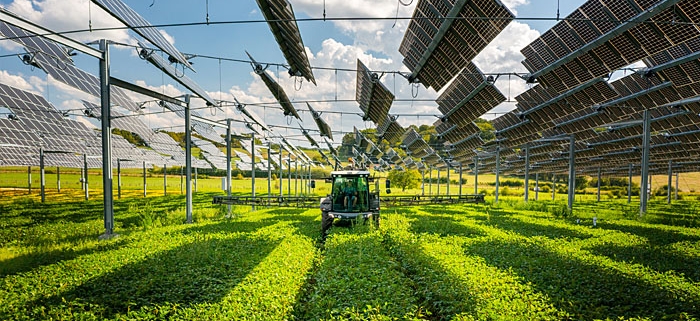What is Agrivoltaics?
Many critics of the current development of solar photovoltaic focus their arguments on the amount of land required for this technology. And not only because of the land occupation but also because of the impossibility of using this land for agricultural purposes, thus, they say, endangering biodiversity, landscape and food security.
The reality is that often this issue is exaggerated. In a recent study, it has been calculated that even if the solar installation targets for 2050 in the USA were met, all the photovoltaic solar would occupy no , in the worst case, more than 0.7% of the natural surface and 2.4% of the agricultural surface. But it is obvious that this is a very sensitive aspect that needs to be improved, and this is why has emerged Agrivoltaics , i.e. the development of solar photovoltaics compatible with agricultural uses.
Although the first pilots Agrivoltaics started around the same time as PV in the 1980s, it is only in the last few years that the technology has started to be developed for commercial application, so it is worth taking a general look to see if it could be one of the big revolutions in solar in the coming years.
-
ADVANTAGES
- More efficient use of the land: By combining uses, renewable electricity can be generated while at the same time the land is used for agriculture or livestock, improving efficiency
- Improved conditions for agriculture: This point is very interesting as the conditions created by the panels benefit certain agricultural uses. This is summarised in s SolaPower Europe’ Agrivoltaics handbook

- Increased social acceptance in general and of rural environments in particular.
- Lower environmental impact and easier to obtain permits.
-
TYPES OF PROJECTS
Agrivoltaics is a concept that encompasses projects that make photovoltaic generation compatible with some type of agricultural or livestock land use. This is why there are a large number of project typologies depending on the use and form of compatibility. Let’s take a look at some of them:

As can be seen in the classification published by Fraunhofer in its Agrivoltaics guide, the first distinction is whether they are open or closed installations (greenhouse type) . If we focus on the open ones, there are 2 main groups:
- Interspace: the aim is to use the space between the rows of panels for agricultural use.

- Overhead: this is the most spectacular as it involves raising the structure supporting the panels to allow agricultural use on the land below.

-
TECHNOLOGICAL CHALLENGES
- Trackers and overhead structures: For overhead systems, probably the biggest challenge is the structures. Raising the panels by a few metres seems simple but has important consequences for the design and cost of the structures. The wind loads are higher, so the foundations have to be increased. In addition, attempts are made to minimise the number of columns, which makes the design more complex.
Fraunhofer estimates that on average, the cost of the structure can be multiplied by a factor of five, without taking into account that these systems are often designed ad-hoc for each project as this project where the manufacturer Alphatracker will supply 100MW of structures in France
In addition to Alphatracker, most tracker and structure manufacturers have launched specific products for Agrivoltaics such as Nextracker, PVH or Axial
- Light management: the light that passes through the panels together with the shadows they cast on the crops are key for the crop to thrive. It is important to design the installation according to the needs of the crop, allowing more or less light to pass through.
- Water management: another detail to consider is how the panels divert rainwater, which can lead to flooded areas.
-
ECONOMIC CHALLENGES
Closely related to this is the fact that these systems are significantly more expensive than systems currently standard. According to Fraunhofer estimates, the LCoE of overhead systems is 50% higher than non-elevated systems.

It seems clear that such projects will need special incentives to develop.
-
EXAMPLES OF PROJECTS
There are 14 GWp of an estimated Agrivoltaics installed worldwide, of which 12 GWp are in China, which (also) leads the world in this technology.
In Europe, we have the interactive map of SolarPower Europe’s Agrivoltaics projects where the projects (mostly pilots) that exist in Europe can be consulted.

France, the United Kingdom and Germany are the countries that the most have worked on development projects and pilots related to these technologies. However, other markets want to make a commitment strong to Agrivoltaics development, such as Italy, which recently held an auction for 1.5 GW of such projects.
Here are some interesting projects that are already operating
-
RWE’s 3.2 GWp pilot in Germany
Very interesting because several typologies have been installed such as interspace with 2P tracker and with vertical panels. Details of the project here


-
Merzig-Wellingen (5.7 MWp in Germany)
interspace installation with normal panels and with vertical panels

-
WineSolar (Iberdrola pilot in Toledo)
Innovative pilot project for overhead solar power coexisting with vineyards. The trackers are made by PVH and it is a very interesting pilot to optimise this type of applications that could be quiet common in Spain

-
APV Waden-Wurttemberg (7 MWp)
There are 5 Fraunhofer pilot projects with elevated structures and different fruit and berry crops.


-
Vendimia (250 MW – Aragon – Lightsource BP)
It stands out as the largest of all those included in the interactive map. The Agrivoltaics typology is the simplest (and perhaps debatable as it may sound like greenwashing) as it involves letting the sheep graze on the solar farm.

In summary, Agrivoltaics has very promising applications especially for area-limited and agriculturally intensive environments. But there is still a long way to go to move from current pilots to profitable commercial projects. In order to achieve this last objective, it will probably be necessary to promote auctions with economic incentives to cover the current cost gap with respect to traditional




